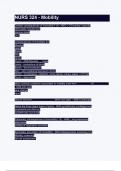Samenvatting
Summary Introduction To Contemporary Work Psychology, ISBN: 9781119945529 Organisational behaviour for industrial engineerin (1JV10)
- Instelling
- Technische Universiteit Eindhoven (TUE)
Summary of all relevant course material, lecture slides, and nodes for the academic year 2020/2021.
[Meer zien]














